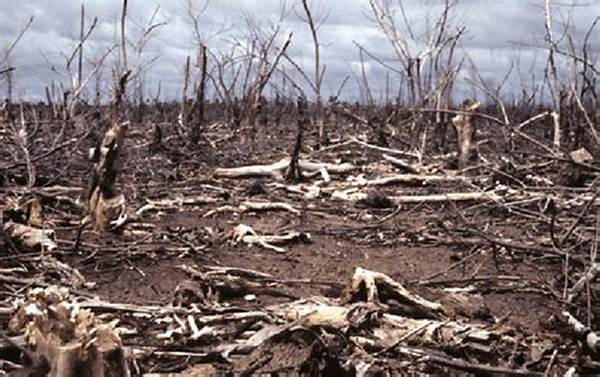The impact of warfare extends far beyond the immediate human suffering and loss of life. One of the grave consequences often overlooked is the destruction of natural resources. Warfare acts as a devastating agent of ecological harm, resulting in the destabilization of ecosystems, depletion of resources, and long-term environmental consequences. The deliberate or collateral damage to natural resources during warfare exacerbates global environmental challenges and hinders post-conflict recovery efforts.
The Environmental Impact of Warfare
Natural resources destruction during warfare has far-reaching environmental implications. During conflicts, ecosystems suffer significant harm, including deforestation, soil degradation, and water pollution. The laying of landmines and the use of chemical weapons contaminate vast tracts of land, rendering them unusable for agriculture or habitation. Additionally, the high energy consumption and pollution associated with military operations contribute to air quality degradation and greenhouse gas emissions, further intensifying global environmental issues. Post-war recovery is also impeded as essential resources become scarce, complicating rehabilitation efforts and prolonging economic instability. Consequently, addressing natural resources destruction during warfare should be a key component in international peace and environmental conservation efforts.
Economic Ramifications of Resource Destruction
1. Economic Instability: Natural resources destruction during warfare severely disrupts economic stability by halting production and trade activities. The scarcity of raw materials leads to inflated prices and weakened export capabilities.
2. Agricultural Collapse: Fields and crops are significantly affected, leading to food shortages and elevated food import dependency, which places additional financial strain on war-torn economies.
3. Loss of Biodiversity: The destruction of habitats and species due to warfare results in the loss of biodiversity, profoundly impacting sectors dependent on natural resources, such as tourism and fisheries.
4. Infrastructure Damage: Warfare often devastates infrastructural facilities critical for resource extraction and distribution, multiplying the economic cost and recovery time.
5. Resource Scarcity: The degradation of renewable resources, such as water sources, complicates efforts to meet basic human needs, exacerbating poverty and hindering long-term economic recovery.
Social Consequences of War-Induced Environmental Degradation
Natural resources destruction during warfare also has profound social implications. It disrupts communities reliant on these resources for their livelihoods, leading to increased poverty and displacement. The depletion of water sources and fertile lands necessitates migration, fueling conflict over remaining resources and contributing to instability. Public health is compromised as polluted environments lead to the spread of diseases, while malnutrition results from food scarcity. Education and community structure suffer as resources are diverted to address immediate survival needs, hindering societal development. Moreover, the psychological impact on affected populations is significant, as the loss of natural heritage damages cultural identity and spiritual well-being. Addressing the social implications of natural resources destruction during warfare is thus vital for fostering sustainable peace and rebuilding resilient communities.
Legislative and Policy Considerations
Effective legislation and policy frameworks are crucial for mitigating natural resources destruction during warfare. International agreements, such as environmental protocols and conventions, must be strengthened and strictly enforced to hold accountable those responsible for environmental damage. Emphasizing the protection of natural resources in conflict zones is essential, with increased focus on preventive measures and rapid response mechanisms. Collaborative efforts are needed to promote sustainable practices post-conflict, ensuring ecological restoration is integrated into peacebuilding initiatives. Furthermore, incorporating environmental considerations into military training and strategy can significantly reduce the ecological footprint of armed forces. By prioritizing the preservation of natural resources during conflicts, a more sustainable future becomes achievable.
Technological Innovations for Resource Protection
In the face of ongoing warfare, technological innovations present promising solutions for mitigating natural resources destruction. Advances in precision agriculture, real-time monitoring, and renewable energy offer the potential to minimize ecological impact during conflicts. Remote sensing technologies can monitor and assess environmental degradation, empowering rapid intervention and restoration efforts. The development and deployment of non-lethal technologies further limit the need for violent confrontations, reducing damage to ecosystems and infrastructure. Encouraging research and development in environmentally-friendly military technologies can lead to more sustainable defense mechanisms. By harnessing technological advancements, the global community can enhance its capacity to protect and preserve natural resources in times of conflict.
Case Studies of Resource Destruction in Conflict Zones
Examining case studies of natural resources destruction during warfare provides valuable insights into the consequences and recovery efforts. The Vietnam War’s use of Agent Orange led to severe deforestation, soil degradation, and long-term health problems. In Iraq, oil wells were set ablaze, causing massive air and soil pollution, while in Afghanistan, deforestation for firewood and grazing destabilized ecosystems. The Syrian Civil War has seen rampant water resource exploitation, worsening the humanitarian crisis. These instances highlight the long-lasting effects of resource destruction during conflicts and underscore the need for international cooperation in addressing environmental recovery as a component of peacebuilding.
Policy Recommendations for Sustainable Recovery
Policy recommendations to address natural resources destruction during warfare must prioritize ecological restoration and sustainable recovery. Increased investment in ecological conservation and rehabilitation projects is essential. Governments and international organizations should collaborate to ensure equitable access to resources and implement sustainable practices. Education and training programs need enhancement to empower local communities in resource management. Transparency and accountability must be enforced in resource allocation and utilization to prevent conflicts over resources. By fostering collaboration and sustainable development initiatives, the international community can ensure effective recovery and prevent future devastation of natural resources during warfare.
Conclusion
The phenomenon of natural resources destruction during warfare represents a critical challenge to global environmental stability and human development. The environmental, economic, and social implications are profound and enduring, emphasizing the necessity for international cooperation, robust legislative frameworks, and technological innovations. Addressing this issue requires a holistic approach encompassing prevention, immediate intervention, and long-term recovery strategies. By fostering sustainable practices and reinforcing peacebuilding initiatives that prioritize ecological preservation, the global community can mitigate the adverse effects of warfare on natural resources. Ultimately, securing the resilience and sustainability of our planet depends on recognizing and addressing the dire impacts of resource destruction in conflict zones.





